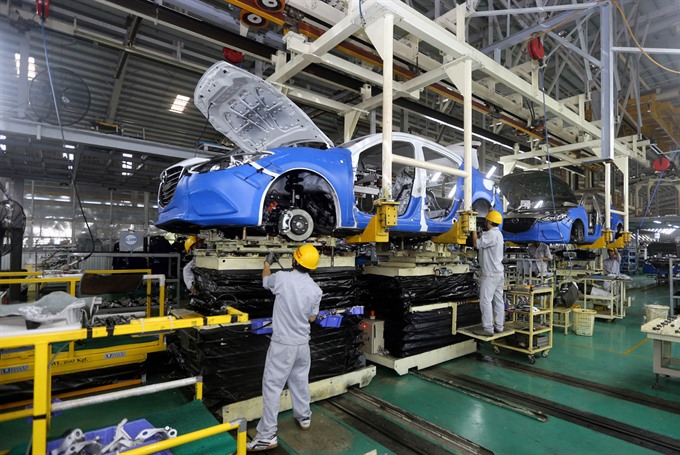 Economy
Economy

The average income per capita in Việt Nam will reach about US$3,000 in 2020 and the demand of cars will boom shortly thereafter, according to the Ministry of Industry and Trade (MoIT)'s forecast.
 |
| Mazda cars assembled at Vina Mazda factory in the central province of Quảng Nam’s Tam Hiệp Industrial Zone. — VNA/VNS Photo Danh Lam |
HÀ NỘI — The average income per capita in Việt Nam will reach about US$3,000 in 2020 and the demand for cars will boom, according to the Ministry of Industry and Trade’s (MoIT) forecast presented on Thursday (October 12) at a seminar in Hà Nội.
At the seminar, in the presence of Government officials and representatives of the Vietnam Automobile Manufacturers’ Association (VAMA) and 200 businesses, MoIT said domestic auto demand could reach more than 600,000 units a year by 2025. At this scale, the market would be able to attract resources for sustainable development.
Meeting the market demand, especially for cars with up to nine seats, would help the country reduce its import turnover by $3-7 billion in 2025, and about $5-12 billion in 2030, contributing to the balance of trade and macroeconomic stability, said the ministry.
Deputy Minister Đỗ Thắng Hải said the industry had achieved remarkable results with total assembling and manufacturing capacity of 460,000 vehicles per year, including light trucks and passenger cars, meeting the goals it set. The industry had contributed trillions of đồng to the State budget per year and generated hundreds of thousands of jobs.
"However, localisation rates [the percentage of locally-made components used to assemble a car] are still low. The part suppliers’ production does not meet the automobile manufacturers’ demand,” said Hải. "The auxiliary industries have not yet formed networks of large-scale auto part and material suppliers and there is no connection among automakers and local part suppliers," said Hải.
In the context of globalisation, the local automobile industry is facing many opportunities and advantages, but also difficulties and fierce competition. Starting next year, the import tariff on vehicles from ASEAN states will be zeroed out if the localisation rate reaches 40 per cent or higher.
President of VAMA Toru Kinoshita said policies need to focus on maintaining the market’s stable growth, reduce the imbalance of production costs between locally-assembled vehicles and imported ones in line with Việt Nam’s international commitments, and promoting development of part suppliers such as training programmes and preferential investment policies.
Market capacity and production output will be crucial factors in the success of the auto industry, said Toru Kinoshita.
“To promote the development of supporting industries, thereby increasing the localisation ratio, the ministry will encourage businesses to invest in large-scale electric vehicles for local demand and export,” said Hải. — VNS




